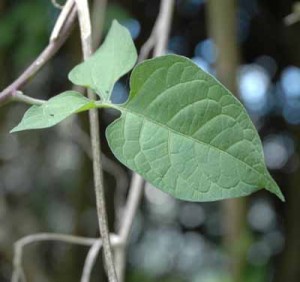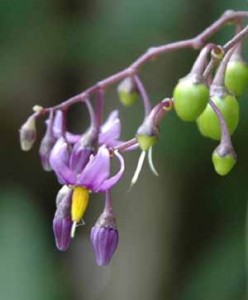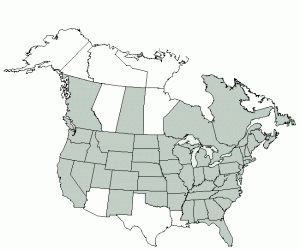Climbing Nightshade
General:
Climbing nightshade (woody nightshade) is native to Europe and Asia and now is widely distributed in North America where it is an invasive plant. Once established it is a problem to remove. It is a double problem since it can grow from both seeds and roots. Although poisonous to livestock, pets and humans I have seen birds eat the ripe berries. The plant has a very distinct order (rather unique and putrid) when cut. Once you smell it you will never forget it. Climbing nightshade is also known as bittersweet, bittersweet nightshade, bitter nightshade, blue bindweed, Amara Dulcis, climbing nightshade, fellenwort, felonwood, poisonberry, poisonflower, scarlet berry, snakeberry, trailing bittersweet, trailing nightshade, violet bloom, or woody nightshade
 Description:
Description:
The plant is a slender climbing or trailing perennial reaching 12 feet in length. Leaves are alternate, ovate, simple or deeply lobed, 1-1/2 to 4 inches long, and pointed at the tip. Flowers are deep purple or bluish purple with flower stalk arising between the leaf nodes or opposite the leaves. Nearly round fruits turn red when mature and stay on the vines through mid winter.
Location:
As the map indicates, climbing nightshade is very common throughout much of North America. Climbing nightshade has a very wide range of habitats, from woodlands to scrubland, hedges and marshes. It is common in suburban areas where it can be found climbing up fences or hedges especially in shaded areas. This grows on my property where pines shade a fence and within a hemlock hedge. The only way I know to organically remove climbing nightshade is to pull the plan and roots. For several years you will need to catch the growth quickly before there are berries.
Poison:
The plant, especially in its green immature fruits, contains steroidal alkaloids, which have caused poisoning in cattle and sheep. 1
Symptoms may include: Vomiting, diarrhea – common and drowsiness. 2
1 http://www.cbif.gc.ca/pls/pp/ppack.info?p_psn=55&p_type=all&p_sci=comm
2 http://www.aspca.org/Pet-care/poison-control/Plants/climbing-nightshade.aspx
Back to Poison Plant Index